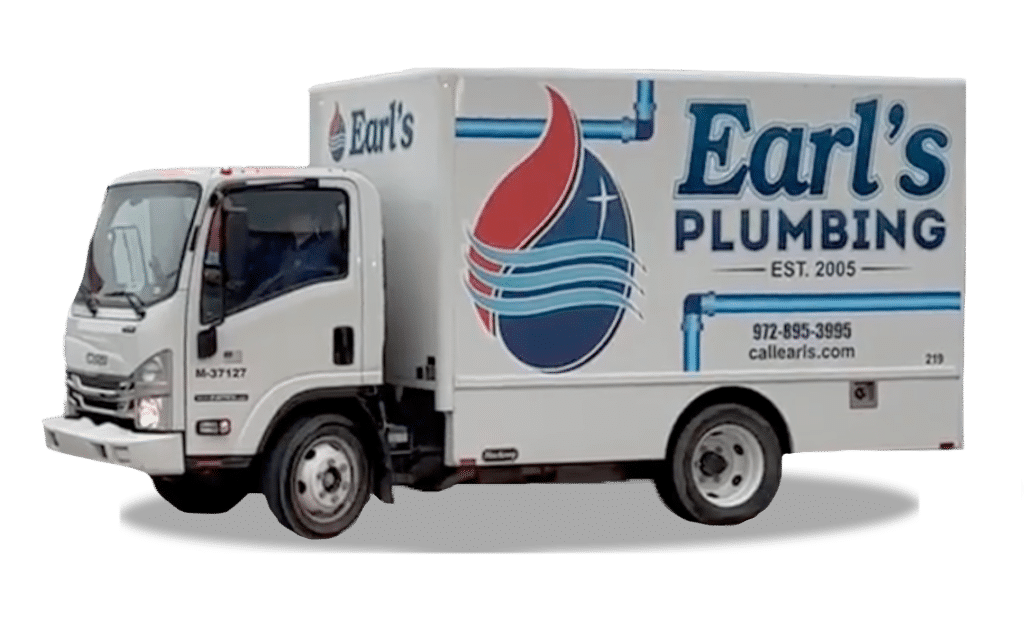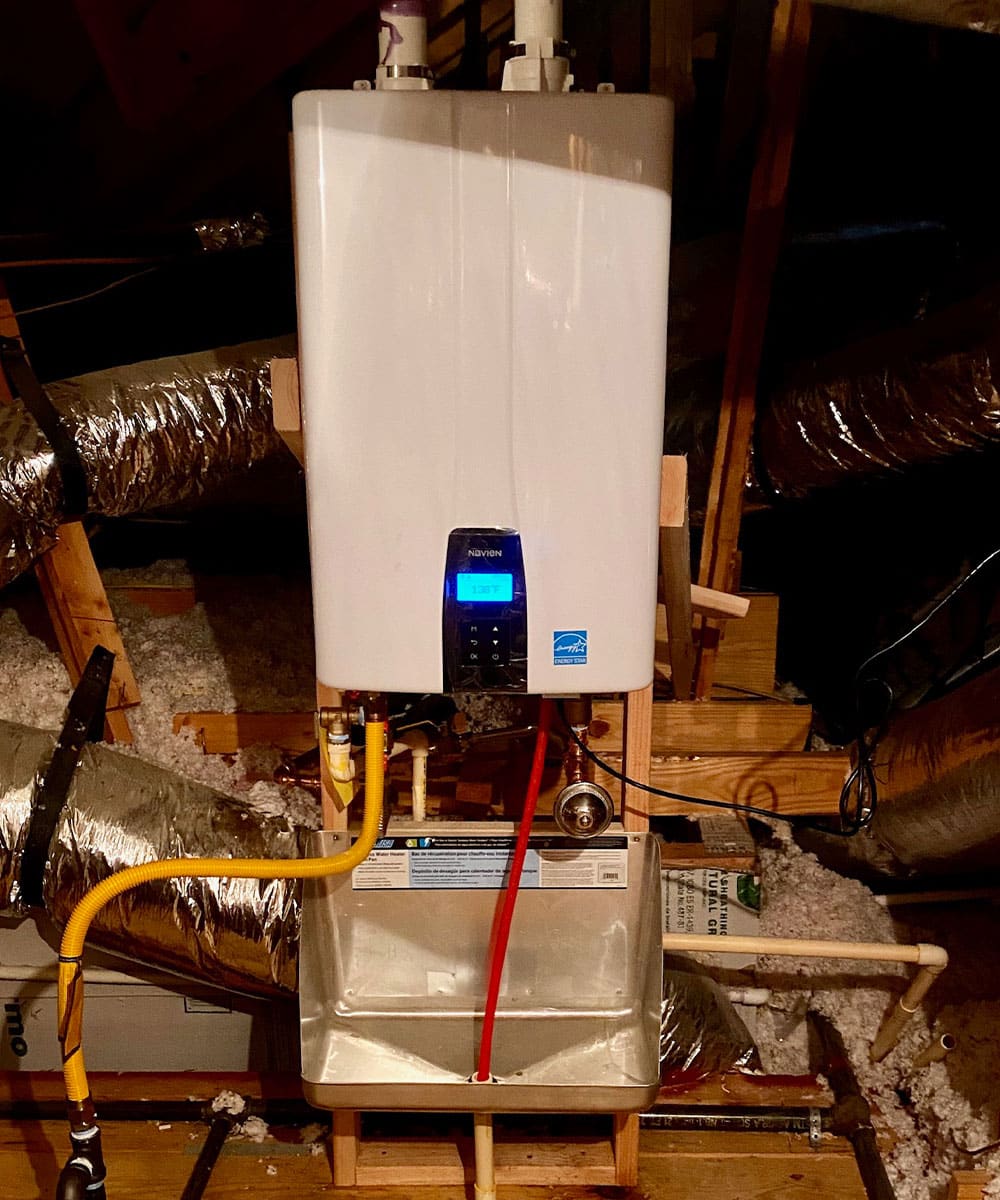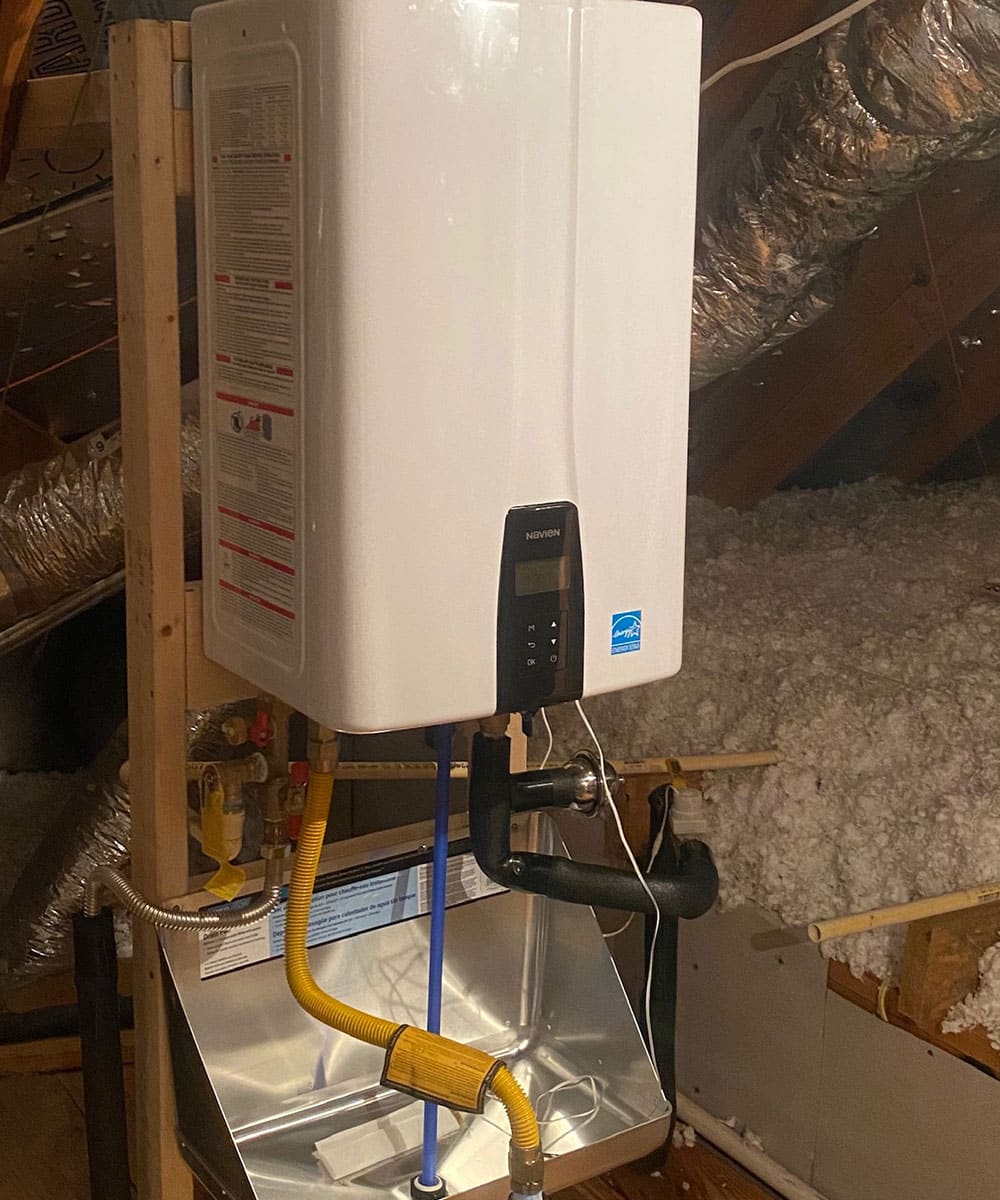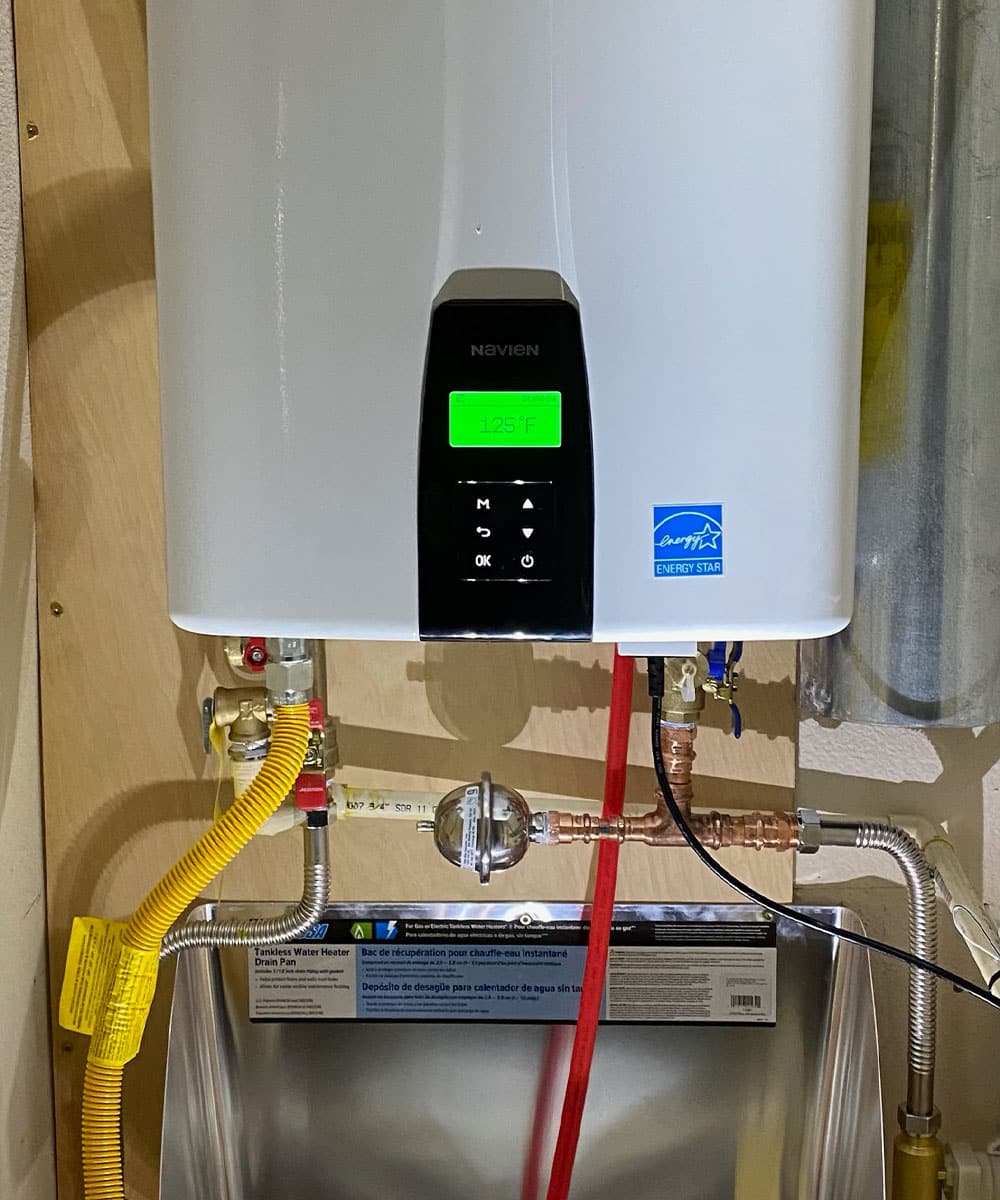Frisco's #1 Tankless Water Heater Installation
What if we told you that you could have an endless supply of hot water that costs you less every month? Tankless water heaters are on-demand, energy-efficient water heating systems that eliminate the need to constantly store heated water. These space-saving, cost-saving, and in many cases property-saving appliances are the next generation of home comfort. That’s why many Frisco homeowners are making the switch!
Earl’s Plumbing is a certified Navien Service Specialist, meaning we’re trained and approved by the industry’s leading tankless brand. There are many benefits to upgrading to a tankless water heating system, and the folks here at Earl’s Plumbing want to make sure that our customers are equipped with all of the knowledge and information possible so that they can make the best decision regarding their water heating needs.
Why Choose Us for Tankless Water Heater Installation?
Let Us Help You Decide if a Tankless Water Heater is Right for You
Earl’s Plumbing became the top installer of Navien tankless water heaters because of our attention to detail and comprehensive pre-installation process. We’re also the only plumbers in the area who build the cost of any necessary roofing work into your tankless installation cost, so you’ll never have to worry about overlooking a single detail in the project.
If you’re interested in switching to tankless, we’ll help you make the right choice for your home, lifestyle, and budget, taking into account:
Read our FAQ section below to learn much more about each of these considerations in detail, with expert advice from our master plumbers!

Request a Plumbing Estimate Today
"*" indicates required fields
Answers to Your Frequently Asked Questions
Because Earl’s Plumbing is the #1 installer of Navien tankless water heaters in the Frisco, McKinney, Plano, Allen, and Little Elm areas, we’ve answered a lot of questions about them! Check out our guide below for an in-depth look at tankless water heater installation.
There are so many follow-up questions that need to be asked to properly answer this one simple question. When the possibility of switching from storage water heaters to a tankless water heater is a viable option, there are many other questions that our team at Earl’s Plumbing will want to ask in order to provide you with the best advice and the various pros and cons of each.
- How many traditional tank-type water heaters do you have right now?
Many people are interested in going tankless, but they only have one tank heater located in the garage. And while we can make that work, it could be total overkill. Ultimately, based on the information that we provide, you can make that choice. But from a price comparison standpoint, a tankless heater installation is a considerable investment and a lot closer in total price to two tank heaters versus one. That’s especially true if the tankless heater is located in the attic. Ultimately, a tankless water heater will pay for itself in utility savings, but that happens a lot faster when the savings comparison is versus two tank heaters instead of one.
- How old are your current tank water heater(s)?
The vast majority of the existing tank heaters installed in this area are classified as 6-year builder-grade water heaters. That means they have a 6-year manufacturer’s warranty—they typically last between 9–12 years. Sometimes they won’t last quite that long. Sometimes, they may go a little longer, but it’s best not to push them too far, especially if they are in the attic or above a living space. To a certain extent, the livelihood can be brand-specific or even supplier-specific. Also, the word “lasts” is a subjective term. To some it could mean “until it leaks” (and causes damage to the home). It could mean “it just stops functioning or heating.” It could mean that one of the two heaters has stopped working, and you should repair or replace the single heater (or just rip off the band-aid and replace both heaters). It could also mean that they are just no longer efficient or that they are making a lot of annoying crackling noise. The most important takeaway here is this: it is always best to be proactive in replacing tank heaters.
- Where are your tank water heaters located—in the attic or the garage?
Location is extremely important. It matters from a risk of property damage standpoint but also from a cost-to-install standpoint. A tankless heater installed in the attic is considerably less expensive than installation in the garage. That’s the exact opposite of regular tank water heaters, where it is actually more expensive to install in the attic versus the garage. Therefore, from a price standpoint alone, it’s almost a no-brainer to go tankless if the unit will be installed in the attic. In fact, it is fairly rare that Earl’s Plumbing installs two tank water heaters in the attic when homeowners are given the choice between tankless and tanks. From a risk potential alone, which scenario sounds more ideal? Storing and continually heating 100 gallons of 140+ degree hot water in rusting metal tanks located above your living room? Or installing a far more energy-efficient, heat-on-demand, Navien tankless water heater that has about 3 gallons of water inside a stainless steel tubing system sealed inside a combustion chamber?
- Do you ever run out of hot water?
Regardless of whether you have one or two traditional tank water heaters, if you are ever running out of hot water, a Navien tankless water heater may be an absolute must. A tankless heater installed by Earl’s Plumbing provides an unlimited amount of hot water at a fraction of the cost. In addition, depending on the version of the tankless water heater that we install, we can most likely significantly reduce the hot water wait times at all of your fixtures. That translates to saving thousands of gallons of wasted water and hundreds of dollars in water utilities every year.
- How many people live in the home, and how many bathrooms do you have?
Depending on the answers provided to this and to previous questions, we may also ask the ages of the residents. Teenagers tend to take longer showers and baths. Younger children will eventually become teenagers. If only two people live in the home with no plans to grow that number and they never run out of hot water, although a tankless heater is an option, it may not be ideal. But in the case of a larger family (5+) and a larger house (5,000+ sqft), two tankless heaters may be required to meet the required expectations. This question also relates to the long-term nature of a tankless heater. For example, a Navien tankless water heater has a 15-year warranty on the heat exchanger. Current testing indicates that in conjunction with the expected routine maintenance and upkeep, Navien engineers think the current versions of their tankless water heaters may exceed 20 years or more! We have removed and replaced older and lesser quality tankless water heaters that have exceeded 18+ years of life.
- How many square feet is your home?
Your home’s square footage is actually one of the least important things we are concerned about. However, some special considerations around capacity and recirculation have to be taken into consideration when the house is over 5,000 square feet. Conversely, when a house is less than 2,000 square feet, other water heating options may make more sense. That is a decision that you can ultimately make based on your individual needs and preferences. We just provide you with the options, prices, and pros & cons.
- What year was the home built in and what city do you live in?
This question combo is important for a couple of different reasons. Certain codes were in place based on the year the home was built and the city in which it was built. Because Earl’s Plumbing installs more tankless water heaters than anybody else in the cities that we serve, we are quite familiar with the obstacles that we could encounter in a particular area or neighborhood versus another. When we have the answers to this question, we may have more follow-up questions or considerations about that particular city.
- What kind of roofing is on your home?
If you call numerous plumbers for quotes on tankless heaters, this is the one question that you should ask them: “Does your install price include a licensed roofer to complete the vent termination?”As far as we can tell, Earl’s Plumbing is the only plumber in the Frisco, McKinney, Plano, Allen, and surrounding area that includes the full turnkey installation with a licensed roofer in our price. Yes, basic roofing work is required in over 95% of tankless water heater installations to properly vent and complete a proper installation of a tankless water heater. We know this because we used to do it the same way that everyone else does. We would tell our customers that they needed to get a roofer out to complete the venting. Months or over a year later, we’d return for another job only to find that the roofing was still not completed. Because this could void the warranty, we started including the roofing part in our service and price. We complete hundreds of tankless installations in the area, so we are familiar with most of the neighborhoods and their respective roofs. But we may ask this question because typical asphalt shingle-type roofs cost us significantly less than new junctions for materials like Spanish clay tiles, slate, metal, or some other types of composite or commercial roofing.
- What fixture in your house has the longest wait time for hot water and how long is that wait?
Answers to this question range from anywhere from “forever” to “over 8 minutes” to “5 seconds.” In reality, an extreme wait time in a larger house without a dedicated recirculation loop is usually no more than 3.5 minutes in the winter and about 2.5 minutes in the summer. If your answer is 5 seconds, then you likely have a dedicated recirculation line. We typically do not see these setups in homes smaller than 5,000 sq. ft. unless it is requested and paid for as an upgrade. Also, larger houses sometimes have to have an extra pump to compensate for the additional head pressure in the lines. This is important because of what we need to do from the recirculation pump standpoint that comes with our Navien tankless water heater installation. Earl’s Plumbing’s flagship and primary go-to Navien tankless water heater is the NPE 240A V2. It accounts for well over 95% of our tankless gas water heater installations. One of its best features is the built-in recirculation pump. With a little “Earl’s Plumbing know-how” we can accomplish what most area plumbers have no concept of—proper use of the recirculation pump’s benefits and dramatically reducing wait times for hot water. Without a dedicated built-in recirculation line across every fixture throughout the home, “instant hot water” is not realistic. But if we can take your 3+ minute wait, give you virtually instant warm water, then blazing hot water in 20-40 seconds, would that be considerably better? It is very possible—in fact, likely, as we do this multiple times a week across homes in Frisco, McKinney, Plano, and Allen. Results vary across different types of construction, plumbing systems, and incoming water pressures, but we do not recall a time that anyone has been disappointed with the end results. There is one other thing to consider when weighing your options. Although we cannot calculate the amount with any certainty due to differences in lifestyles, the water waste savings are likely considerable. Take the recirculation option (tankless or tank) in an average-sized home with an average-sized family of four people that have relatively normal bathing and washing routines. The greatly reduced hot water wait times could save in excess of 15,000 gallons of water waste per year, per house. This is in addition to the annualized gas utility savings and the first-year tax incentives and utility rebates!
Navien is the #1 selling tankless water heater in North America for a reason. They have the longest warranty in the industry (15 years). They use superior products, such as stainless steel instead of copper. The engineering concepts and design are superior yet simple—just by looking inside a Navien heater, the differences are obvious. And they stand behind their products.
In fact, we feel so strongly about the Navien brand that we have told customers in the past that had other brand preferences that they should choose another plumbing company.
During the water heating process, the condensing heater produces a significant amount of moisture in the exhaust. This moisture accumulates and forms condensation that is captured and funneled to a collection area. Then, it must exit the heater through some sort of drain line.
Condensing heaters like the Navien NPE 240A also have additional very valuable features and benefits that make a significant difference in the performance and user experience. And although condensing tankless water heaters cost a little more upfront, they do not require any proprietary venting like most non-condensing types do.
In summary, you should ALWAYS go with a condensing heater like the Navien NPE 240A unless the only option available is a non-condensing heater like the Navien NPN 199.
In all honesty, Earl’s Plumbing can do just about anything you want to do plumbing-wise, as long as you’re ready to spend the money. But we like to think of ourselves as good partners and can sometimes figure out alternative solutions to get you the end result that you want without breaking the bank.
When we get this question, it is usually an after-the-fact response to a problem that has happened previously, such as a ruptured tank heater in the attic that flooded the house. We always tell our customers that they must be proactive with tank heaters that store 100 gallons of hot water above their living area. They do not always take our advice and occasionally wish they had. But we can offer solutions that often make more sense than a costly relocation.
In Texas, we occasionally get an odd couple of days where it is far colder than building codes expected or predicted. Those extreme events are once in a 20–30 year period, like what happened in February 2021. But there are steps to take to prevent damage to your tankless water heater in those rare events where it gets and stays below 15 degrees for multiple days in a row.
As long as you follow our steps and advice, you will be fine. The key here is water flow—regardless of if you have tank water heaters or tankless water heaters.
In February 2021, we saw staggering property loss due to historically low below-freezing temps. People that listened to the news anchors, government agencies, or a handyman instead of advice from a licensed plumber probably learned some costly but valuable lessons. The customers that followed our advice not only did not lose their tankless water heater—they also had minimal to zero water pipe ruptures or home damage.
Also, their lines never froze, and they never lost the use of water—except for some of those with a water softener.
If you have a water softener that was installed incorrectly by an unlicensed supplier (we rarely see them done correctly), then there is probably nothing that we can do for you outside of completely reinstalling their incorrect work. That can only be done proactively—NOT the week before, the day of, or worse, during the weather event.
Sometimes getting the cheapest price means getting cheap and inferior results. There is a right way and countless wrong ways—the right way is always more labor-intensive and usually costs a little more. So, buyer beware!
In time, as the age of homes ready for replacement changes these percentages will also change.
- Attic installation vs. Garage installation: The process for these two types of installation is similar but there are significant differences between installing a new tankless water heater in the attic versus the garage. The first is price.
- Swapping Out Tankless for Tankless: There is a significant difference when we are swapping out an existing tankless heater for a new tankless model. In most cases, the price difference in a swap versus a brand-new retrofit can be significantly reduced. We are a lot more limited in what model we can install, but in most cases, the water lines, electrical, and in some cases the venting is already in place and sometimes can be repurposed.
- Exterior Cabinet-Mounted Installation: Many homes these days have tankless heaters mounted in cabinets on the outside of their homes. Typically, these are in-model proprietary metal cabinets and hidden from view. Some homeowners do not even know where their water heater is until there is a problem. In our professional opinion, this install type is less than ideal because of the future limitations in the heater brand as well as the size and capacity. But we’re pretty sure the manufacturers thought of this and purposely made it that way. These units are the size of a suitcase, so they could go anywhere during the construction process. In addition, we also feel that these locations are ripe for issues such as freezing, air intake problems, and overall longevity. Regardless, a swap install involves considerably less labor and materials and therefore price. But please note we have significant limitations in what we can go back with and/or how we can improve the water heater performance and production.
PROS: Benefits of Tankless Water Heaters
- Unlimited and endless hot water
- More energy efficient than tank water heaters, usually saving more than $400 a year in gas utilities
- Utility provider rebates of $250 (available from Atmos only)
- Federal Income Tax Credits up to $600 (available on Ultra High-Efficiency models only)
- One tankless (Navien 240A) typically replaces two traditional tank heaters, freeing up space that you might need for other things
- When installed correctly, our Navien “A” series tankless water heater can greatly reduce hot water wait times, saving thousands of gallons of water waste on an annual basis
- Significantly reduced leak exposure and loss mitigation benefits
- Durable and long-lasting, with a lifespan up to 20 years when properly maintained and a 15-year warranty on the heat exchanger unit
CONS of Tankless Water Heaters
- Tankless water heaters require annual maintenance. Contrary to some beliefs and some plumbing sales gimmicks, annual flushing for a traditional tank heater is not required and has minimal to zero benefits. But with a tankless water heater, regular but relatively low-cost maintenance must be performed.
- On really cold days during the winter when the incoming ground water temperature is extra low, you may see an overall pressure or flow reduction when using more than two fixtures by design. This is for the extra time that it takes to rapidly heat the cold water to the desired and set temperature. This is very brand and model dependent, but all tankless heaters are impacted to some degree.
- Leak Damage Mitigation Device: For loss mitigation efforts we stock and install a product called Flood Stop. We highly recommend this for both traditional storage tank and tankless heater installations, especially when the water heaters are located above a living space or in the attic. This emergency shut-off valve instantly stops the water flow at the slightest sign of moisture and sounds an alarm. The cost is very low, and homeowners select this option on about 80% of our attic installs.
- Navien Peak Flow-A Anti-Scale System: This is a pre-filter product from Navien. It uses a process known as TAC or “Template Assisted Crystallization.” It does not soften the water but has a positive effect on scale prevention inside the tankless heater as well as on the faucets, fixtures, and glass—without using chemicals or salt tablets.
Condensation Neutralizer Kit: This option is very home and job-specific and may be required if your home was built before 2005. The wastewater condensation that is produced during combustion is slightly acidic. Even though the acid level is very low (less than vinegar), it can over an extended period of time cause erosion of the copper pipe and fittings, causing a leak inside the wall. To prevent this, we must install a condensate neutralizer on the wastewater line that raises the PH making the wastewater neutral. - Water Softener or Conditioner System: Our water quality in Frisco, McKinney, Plano, Allen, and the immediate surrounding areas is primarily sourced from Lake Lavon. The average water hardness for 2022 was measured at 8.6 GPGs. On the hardness scale, this is considered moderately hard but on the lower end of that classification. With a water hardness of 8.6, it is not a warranty requirement to have a water softener or conditioner installed. However, the hardness level is considered high enough that regular and consistent descaling and maintenance must be maintained. It should also be noted that water hardness actually doubles when being heated at the high temperatures required for a tankless water heater to properly perform. Water softeners can not only negate that effect and extend the life of the tankless water heater but also reduce the scale buildup on your faucets, fixtures, dishes, and shower glass. They can also help with dry skin and hair! Any salt tablet or water conditioning system, such as the HALO or AquaSana systems, can help.
See What Frisco is Saying About Our Tankless Water Heater Services




